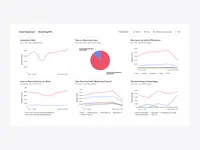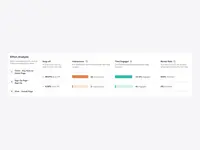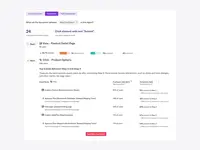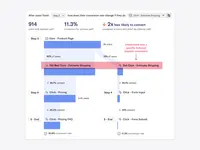Overview
What is Heap?
Heap is a web analytics platform captures every user interaction on web iOS with no extra code. The tool allows you to track events and set up funnels to understand user flow and dropoff. It also provides visualization tools to…
The collection and processing of data is automated.
Solid Data Tool
Heap : Simplified Customer Analytics for Dummies
An essential tool for studying user behavior!
Heap - Insights in the digital world
Auto-capture every user interaction with no manual event tracking. No messy tracking plans. No custom ETL pipelines
We use Heap to auto-capture every user interaction in our website. it used by the product and …
power of AI/ML meets with Best UI/UX to deliver optimal ROI
Great Platform to generate User Interaction data and gather actionable Insights
Heap Product analytics
Robust software with great analytical capabilities
great automated data collection.
Heap Review
So we are …
Good product
Heap - a great Digital Insight Platform
Heap: Identify your website logical path to improve sales.
Awards
Products that are considered exceptional by their customers based on a variety of criteria win TrustRadius awards. Learn more about the types of TrustRadius awards to make the best purchase decision. More about TrustRadius Awards
Pricing
Free
$0
Growth
Starting at $3,600 annually
Pro
Contact Heap Sales
Entry-level set up fee?
- Setup fee optional
Offerings
- Free Trial
- Free/Freemium Version
- Premium Consulting/Integration Services
Product Demos
Fibonacci Heap Demo
Imogen Heap Performance with Musical Gloves Demo
PANASONIC - BREAD MAKER (SD-P104) - (DEMO) BY HEAP SENG GROUP
HAPPYCALL - 'DIAMOND' DOUBLE PAN (DEMO) BY HEAP SENG GROUP
Heap: A Smarter Approach to Product
The Gloves Music Controller Demo with Imogen Heap | Digital Transformation
Product Details
- About
- Integrations
- Competitors
- Tech Details
- Downloadables
- FAQs
What is Heap?
- Improve customer experience: Pinpoint exactly where users are struggling and make improvements to the customer experience, driving an intuitive, enjoyable user experience.
- Speed time-to-market and optimize the impact of product and business teams: Rather than relying purely on gut instinct, leverage digital engagement data to test hypotheses and answer questions as they arise. With data-driven insights, confidently bring new features & experiences to market.
- Build increasingly valuable features and experiences: Leverage data to build consensus on engineering investments that can be clearly tied to business outcomes.
Heap Features
- Supported: Autocapture (Codelessly capture every interaction/event in a product or website)
- Supported: Event Visualizer (Locate, tag and name events with this tool)
- Supported: Data Engine (Data Dictionary and Governance tools provide control and organization of data)
- Supported: APIs (Augment data with flexible APIs)
- Supported: Sources (Import data from other tools)
- Supported: Reporting and Dashboards (Get insights on activation, retention, conversion, engagement and other key digital/product metrics)
- Supported: Ad-hoc Analysis (Retention, Conversion, Funnel, Cohort analysis, etc)
- Supported: Heap Connect (Bring user data with managed ETL into warehouses such as Snowflake, Redshift)
- Supported: Heap Activate (Drive action base on Heap data via connectors to Appcues, Marketo, Intercom, and Salesforce)
Heap Screenshots
Heap Videos
Watch Heap - A Smarter Approach to Product. What is Heap and how does it work?
Watch Customer story: Northwestern Mutual becomes data-driven with Heap
Watch Customer story: Snapfish Uses Heap’s Omni-Channel Tracking to Increase Conversions
Watch Customer story: E*TRADE's analytics team delivers insights with Heap
Heap Integrations
Heap Competitors
Heap Technical Details
| Deployment Types | Software as a Service (SaaS), Cloud, or Web-Based |
|---|---|
| Operating Systems | Unspecified |
| Mobile Application | No |
| Supported Countries | Americas, EMEA, APAC |
| Supported Languages | English |
Heap Downloadables
- Product Analytics Buyer’s Guide: A guide to choosing the right product analytics solution
- Heap's Digital Experience Insights Report: How to Miss Everything About Your Users (And How Not To)
- Digital Insights Are a Superpower: A comic book about how to use data to transform your customer experience
- Heap's 3 Templates for Uncomplicating Product Management: Bring your Product Management processes into the future with structure and a shared knowledge base
- Using Digital Analytics to Drive Business Outcomes: How to Align People, Process, and Technology
Frequently Asked Questions
Heap Customer Size Distribution
| Consumers | 0% |
|---|---|
| Small Businesses (1-50 employees) | 40% |
| Mid-Size Companies (51-500 employees) | 40% |
| Enterprises (more than 500 employees) | 20% |
Comparisons
Compare with
Reviews and Ratings
(382)Community Insights
- Business Problems Solved
- Pros
- Cons
- Recommendations
Heap is a highly versatile analytics platform that has been widely used by organizations to collect and analyze customer data. Users have found Heap to be a powerful tool for automatically tracking customer behavior and understanding their journey. From keeping metrics in check and tracking against key performance indicators, Heap has proved its effectiveness. It has helped teams track the performance of newly released features, identify areas for improvement, and understand both user and system behavior of applications.
Heap has been valuable in enhancing the understanding of customer behavior, improving user engagement, identifying pain points, and mapping out the user journey. It enables organizations to validate hypotheses, pilot test new features, and determine the success of those features. Users appreciate how Heap helps them identify issues in the user experience, summarize interactions, and ultimately improve the overall user experience. By delving into customers' digital journeys, Heap allows companies to better design processes, increase platform usage, and pinpoint areas of easiness and difficulty for customers.
In addition to these applications, Heap serves as a powerful tool for tracking and analyzing user interactions, determining adoption and usage statistics, segmenting users into multiple buckets, verifying default assumptions, locating friction points in processes, building customers' digital journey, creating graphs and charts for analysis in various industries such as healthcare and finance. Heap also supports funnel optimization by providing insights into drop-off points and channel performance. Whether it's the product team making data-driven decisions or marketing personnel measuring traffic sources and conversions, Heap offers valuable analytics data across different functions within organizations.
Overall, users rely on Heap to gain deep insights into user behavior, make informed business decisions, improve user experience based on audience segments, track conversion rates and usage patterns, measure product performance against competitors. It helps understand customer engagement with websites or apps, extract insights on users' tendencies within pages or forms. It evaluates clicks and funnels while monitoring various metrics such as conversions, page views, enrollment rates, etc. Heap's ability to provide comprehensive data analyses, flexible tracking capabilities, and valuable input for product decisions has made it an essential analytics tool for companies seeking to improve their understanding of customer behavior and drive business growth.
Intuitive and User-Friendly Interface: Users have consistently praised Heap for its intuitive and user-friendly interface. It has been mentioned by many reviewers that the interface makes navigation and task completion easy.
Highly Praised Event Visualizer Tool: The event visualizer tool in Heap has received high praise from users for simplifying the process of defining elements to track engagement without the need for additional coding. Several reviewers have highlighted this feature as a standout aspect of the platform.
Auto-Capture Feature: Many users appreciate Heap's auto-capture feature, which automatically records all events on their website. This eliminates the need for manual tracking and saves valuable time for businesses. The convenience provided by this feature has been highly regarded by multiple reviewers.
Confusing User Interface: Several users have expressed frustration with the user interface, particularly when it comes to defining reports. They feel that the current approach is confusing and suggest a simpler and more intuitive design.
Difficulties with Filtering and Group-by Selection: A number of users have encountered difficulties while filtering events in the graph report. Additionally, they mention that the group-by selection often gets reset in funnel reports, causing inconvenience and extra effort.
Steep Learning Curve: Users have found the learning curve for using the platform to be steep. Many feel that technical knowledge is required to use it proficiently, which can be a barrier for non-technical or less experienced users.
- Implement Heap as soon as possible to start capturing all analytics and defining events easily. Prioritize creating a data strategy beforehand, including key performance indicators (KPIs) and meaningful analytics for the organization.
- Complement Heap with other analytics tools to cover everything not planned for in regular analytics. Consider using Heap as a separate tracking system compared to traditional tools like Omniture or Google Analytics.
- Thoroughly learn the documentation of Heap to fully utilize its capabilities. Do not hesitate to reach out to Heap support for assistance with any questions that arise.
Users also find Heap valuable for understanding user behavior, making data-oriented decisions, and improving products. They appreciate its ability to capture all analytics and save time by enabling more employees to build out analytics.
Attribute Ratings
Reviews
(1-25 of 59)Solid Data Tool
- Data readability
- Increasing reporting confidence
- Including more thorough definitions
- Documentation on suggested data manipulations across industries
- Extract data on specific customer activities
- Real time reports can be extracted
- Providing charts and graphs to understand data points effectively
- Comparing data of different time funnel can be optimized
- Too much data is generated, which require additional support to segment
Heap - Uses Data mining for Data Analysis
Heap does the exact same thing, it balances both using data analytics. using both predictive framework and adaptive framework it help to achieve the requirements.
In predictive framework it uses past data for analysis where as kn adaptive framework it uses data on fly to achieve the requirements.
Based on scenario we can use both the models.
- This can be used to find is a Customer is about to leave a product or not
- It can also help to know if any default might have based on customer's past performance
- It can let us know what is the next best possible action that needs to be taken
- Since Heap deals with lot of data, data base is a huge issue
- Encryption and decryption algorithm has to be structured in a larger scale
- Integration with other systems using heap is difficult, this has great scope for improvement
Super intuitive, easy to set up, erases the painful memories of Google Analytics 4. Good job Heap!
- The Auto Capture function does indeed save quite a bit of time, and being able to build new reports off historical data is really valuable.
- Interface is really intuitive and user-friendly. Much easier to pick up and use than GA.
- Building reports out on the fly is really quick and easy, allowing you to give right into all kinds of analyses.
- The Event Definition screen is really useful, giving a quick glance at the most used events, which you then decide to turn into conversions or goals if you want.
- Could maybe do with some more guidance or out-of-the-box help in setting up ecommerce-specific reporting, as it almost always will need a custom setup.
- There's quite a lot of extraneous data in the funnel reports, e.g., auto-suggestions of steps to add in, that I feel create more noise than clarity (I don't particularly want to add in a name field to the steps, for instance).
- I find the Influence and Path reports pretty hard to fathom, so don't use them much. Can see how they would be useful, but they are too difficult to understand.
- I found Marketing Channel set up weirdly difficult to wrap my head around, whereas it's much easier in GA. In general, more around attribution of marketing channels would be good.
Heap helps driving better product insights and results
- conversion funnel analysis
- product split test reporting
- product feature usage tracking
- Simpler UI
- Auto capturing events means we can go back and analyse things we didnt know we needed at the time.
- Huge flexibility in reporting which allows us to create a wide range of insights from both client side and server side data points.
- Ever enhancing feature set.
- Being able to tell a story with the data in a more contextual manner.
Heap is well suited for teams that dont want to rely on engineering or data science teams to support. Effectively you dont need to be a hardcore data person to get great value from the tool.
Heaps of Value!
- Conversion metrics.
- Event tracking.
- Funnel building.
- It's a little confusing to use at first.
- The findability isn't the best when looking for certain features.
Finding the needle in a Heap using HEAP
- Build a conversion funnel
- Identify unintended paths using the paths from feature
- Map out nonlinear journeys with forking option
- Generate reports on wait times between urls
- Creating an event becomes difficult when proper dimensions are not selected
- No option for creating an opposing event
- Alerts or notifications when things are not going well like an alert system
Heap doesn't work well where you want to create segments based on certain criteria or user behavior. Also, adding more granular details to events is something that they should look at.
Great Tool if You Know How To Use It
- Event capture
- Easy report creation
- Sharing and collaborating on reports
- Unable to create data tables
- Hard to find session-level metrics
- Missing some key metric reporting, like bounce rate
HEAPS Feature that you will indulge
- Segmented users
- User friendly
- Easily do tracking based on the element on the website
- Don't have details analysis tie with our actual online sales
- Don't have time spend for each users
- Don't have enough detail analysis like bounce rate and etc
As a non-technical person, it's easy and fun to use!
- The UI is incredibly clean and easy to use.
- It's easy to share the dashboard when needed.
- The querying is also very easy to use and get started on my first time.
- The navigation and its icons could be improved -- sometimes, I don't know what each category is referring to.
- There is a lot of functionality in Heap that I didn't know existed until I met with a researcher. I'd love more onboarding and educational resources from Heap.
I wish I did more of setting up queries myself with the functionality where Heap can create paths of data in the UI that do not exist already. I think that would be super useful but unfortunately just forget how to do it sometimes!
Heap saves PMs' days.
- Retroactive tracking
- Visualizer
- Onboarding
- UX is not as friendly as other tools like FullStory.
Heap has got it all
- Historical data tracking so you dont miss out on things if you dint know what to track
- Playbooks so we're able to set things up quickly
- Informative dashboard suggestions. It might not be all end all but it helps us connect the dots in case we've missed anything
- Aggregation of data is pretty hard. For eg. data in Looker is not sure how easy that integration looks like from a data warehouse.
- Data is sometimes hard to understand. It spits out different values just by changing dates
- Segments could be improved they only provide limited functionality
- Sharing reports is an absolute pain. Unless someone is invited to a project they cant view it just keeps giving them errors. I've used other tools like Mixpanel / amplitude we can freely share stuff. With Heap, it's like you have to go through RBAC to do basic things. There should be at least a basic sharing mechanism so we can share reports with stakeholders.
A solid tool for product analytics
- Funnel analysis
- Segmenting users based on prior behaviors
- Automated threshold alerting
- Optional events in funnel analysis
- Data dictionary/validation
- Sophisticated filtering and reporting with formulas
Excellent analytics tool with lots of potentials
- Flexible event definition
- Wide range of integrations
- Funnel analysis
- Identity API
- Limited logic filters within reports
- Fairly steep learning curve
- Attribution modeling
- Event Visualizer can be improved
Dealing with the Simple things
- Funnels/conversion tracjing
- Click tracking
- Redux integration
- Filtering, sorting, and tracking by event properties
- Faster queries
- Caching
A conversion rate optimization must!
- Analyze Funnels
- Quickly define key events on a website
- Produce graphs seamlessly
- Use case tutorial videos
- User friendly.
- Robust.
- Data rich.
- Data governance.
- Organization.
- Lack of visualization customization.
Heap is okay
- Somewhat intuitive interface
- Realtime reports
- Custom defined events and conversions
- Attribution modeling
- Faster loading of data
- Easier segmentations
Heap Review
- auto-capture
- simple ui
- robust integrations
- help with data cleanliness
- visibility into "who" created custom api events
Heap is one of the best purchases you can make
- Retroactive data storage - even if you forget to define an event, the data isn't lost.
- Much better user interface than Google Analytics, easy for non-tech marketers to use without eng support.
- Real-time data analysis - so we don't have to wait for the data
- Easy ability to cut data in different methods quickly
- Some room for improvement around the automation of data subject access requests (having API for bundling these requests) for GDPR / CCPA / CPRA compliance.
Solid Product, with room for growth
- Data Visualization
- Funnel Construction
- Clunky user controls
- Auto captures all customer activity
- Saves all data historically. If you forget to define an event, you can do so later and still look at it historically.
- Ease to define new events and create naming systems.
- Has no session recording/screen recording options
- Continue to build out more integrations
The most efficient way to make your site more efficient
- Track a user over time.
- Highlight differences between desktop and mobile behavior.
- Identify the most common path from point A to point B.
- Multi-touch attribution modeling.
- Identifying the referrer for a particular user or session.
- Registering the full impact of paid ads.
Using Heap at startups
- Allows non-technical users to define events.
- Retroactively captures all events.
- Provides analysis suggestions when investigating funnels.
- Broadening the suggestions that Heap surfaces.
- Including categories when searching events.











